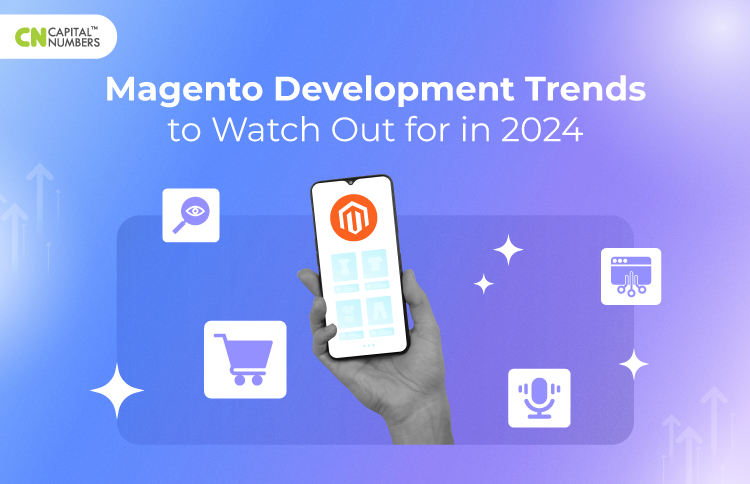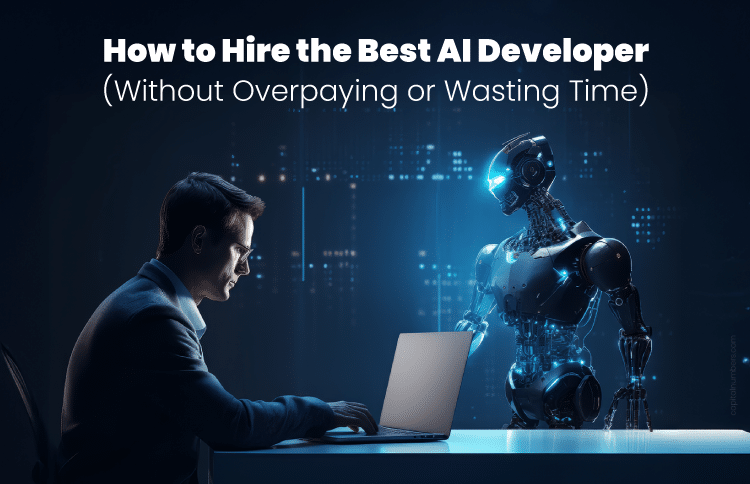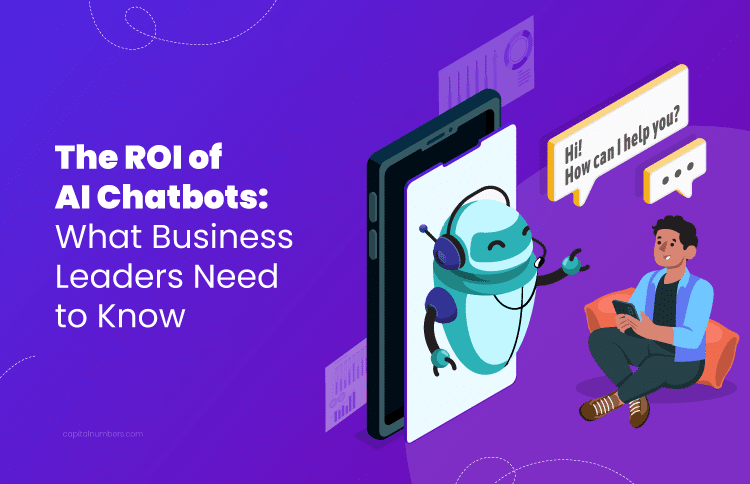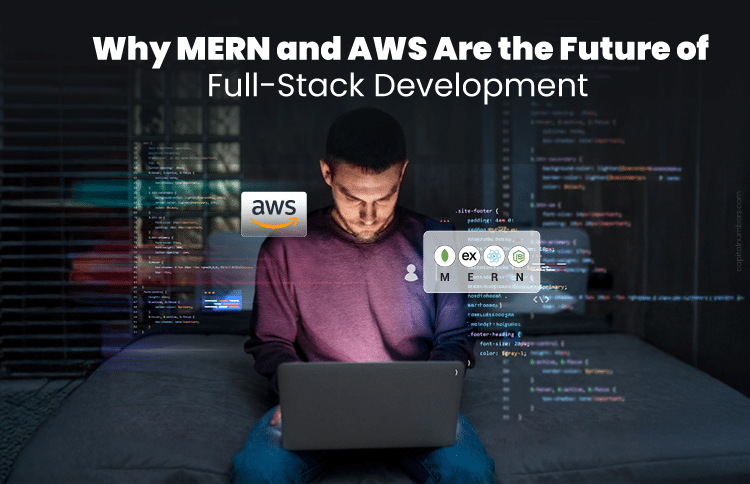Magento Development Trends to Watch Out for in 2024
Table of Contents
In the fast-paced world of E-commerce, Magento shines as a favorite among both companies and developers. Its flexibility suits businesses of all sizes, while developers prefer its scalability and ease of customization. However, having a Magento store alone won’t guarantee success in the competitive digital market. To stand out, businesses need to update their stores with the latest features. This highlights the importance of Magento development trends for 2024.
Magento Development Trends in 2024
In 2024, emerging trends are transforming online shopping and how businesses interact with customers. It’s essential to hire expert Magento developers to navigate and capitalize on these changes, thereby enhancing your E-commerce platform. Moreover, staying informed about these trends is critical for making informed strategic decisions and leading your development team effectively. This blog outlines key trends set to influence the market in 2024. Continue reading to stay ahead.
1Headless Commerce
Headless commerce is a hot trend in Magento. It’s about decoupling the front end, or the part of your website everyone sees, from the backend, where all the commerce magic happens. This setup lets developers build custom, dynamic user experiences with modern tech like React or Vue.js, while Magento’s strong backend takes care of products, orders, and payments.
Decoupling helps your business quickly adapt to new customer preferences and market trends without overhauling your entire online store. It also improves your website’s performance and scalability, as resources can be fine-tuned without the limitations of traditional setups. For businesses looking to integrate Magento with other systems, like CRM, ERP, and marketing automation, headless commerce creates a seamless link, offering a consistent customer experience across all platforms.
2Progressive Web Applications (PWAs)
Progressive Web Apps (PWAs) is one of the popular trends in Magento development, offering various features to enhance user experience and boost performance. With PWAs, Magento developers can create fast, reliable, and engaging web experiences that mimic native mobile apps. Key features include offline capabilities, enabling users to access content without a stable internet connection.
Also, PWAs offer seamless integration with device features like push notifications, camera access, and geolocation, improving user interaction. Their responsive design ensures a consistent experience across devices. PWAs are installable, allowing users to add them to their home screens without going through an app store. Thus, it increases accessibility and visibility.
3Adobe’s Microservices Approach
Adobe’s microservices strategy for Magento is revolutionizing E-commerce by breaking the platform into smaller, independently deployable services. This approach enhances flexibility, allowing businesses to quickly adapt features and fix issues without impacting the system. Microservices communicate through APIs, making the platform more resilient and scalable.
By leveraging Adobe I/O for serverless computing, businesses can execute code based on events, streamlining operations and reducing costs. The push towards Progressive Web Apps (PWAs) within this architecture means Magento stores offer fast, app-like experiences with offline capabilities. Seamless integration between the front-end and back-end is achieved using GraphQL and REST APIs, ensuring smooth data flow and a unified user experience.
Adobe’s microservices approach marks a new era for Magento, empowering businesses with agility, efficiency, and the ability to innovate in a competitive digital landscape, all while maintaining a customer-centric focus.
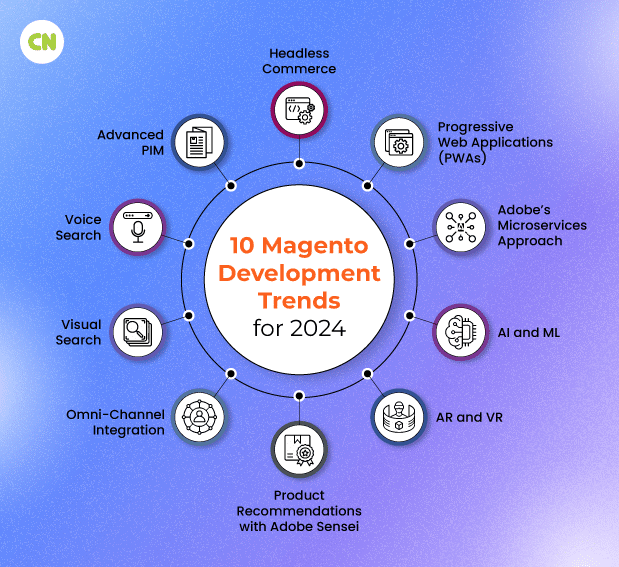
4AI and ML
Artificial intelligence and machine learning are emerging trends in Magento development, revolutionizing E-commerce. AI in E-commerce brings to life advanced features such as personalized product recommendations, customer service chatbots, and predictive analytics for managing inventory. These innovations enhance the shopping experience and boost sales. Using AI algorithms, Magento developers can automate repetitive tasks, optimize marketing strategies, and gain valuable insights into consumer behavior.
As E-commerce continues to evolve, integrating AI and ML into Magento platforms becomes essential for staying competitive and meeting the demands of modern consumers. Using these technologies helps businesses deliver hyper-personalized experiences, streamline operations, and stay ahead in the digital marketplace.
5AR and VR
Integrating Augmented Reality (AR) and Virtual Reality (VR) with Magento E-commerce can revolutionize how businesses connect with customers. These technologies immerse shoppers in virtual showrooms or let them visualize products in real-life settings directly from their devices. This immersive experience not only boosts engagement but also reduces the hesitation often associated with online purchases, potentially decreasing return rates.
For businesses, the adoption of AR and VR can lead to higher conversion rates as customers feel more confident about their choices. It’s an innovative way to highlight product features, giving brands a competitive edge online. Additionally, these interactions provide insights into customer preferences, aiding in targeted marketing and product development. AR and VR in Magento E-commerce can thus transform the shopping experience, increasing customer satisfaction and loyalty and driving sales.
6Omni-Channel Integration
Omni-channel integration is revolutionizing the Magento development in 2024 by seamlessly connecting online and offline shopping experiences. With this trend, businesses can offer consistent and personalized interactions across various channels, including websites, mobile apps, social media, and brick-and-mortar stores.
By integrating inventory management, order fulfillment, and customer data, businesses can provide a unified shopping journey, improving convenience and customer satisfaction. Omni-channel integration empowers Magento developers to build flexible and scalable solutions that adapt to evolving consumer behaviors and preferences. Choosing this trend enables businesses to stay competitive in today’s digital landscape and deliver seamless experiences that drive engagement and loyalty.
7Visual Search
Visual search is an emerging trend in Magento development, revolutionizing how users interact with online stores. This feature allows customers to search for products using images instead of text, streamlining the shopping experience. Shoppers can discover similar products from the catalog effortlessly by simply uploading a photo or taking one. It enhances product discovery, reduces friction in the buying process, and boosts conversion rates.
As consumer preferences shift towards visually-driven experiences, consider the integration of visual search to stay competitive in the E-commerce market. Magento offers several extensions for implementing visual search seamlessly into your online store.
8Product Recommendations with Adobe Sensei
Magento product recommendations powered by Adobe Sensei are a game-changer for business owners. This smart feature uses Adobe’s artificial intelligence to understand customers’ shopping habits and preferences. It suggests products they’ll likely buy, making their shopping experience personal and engaging.
For business owners, this means your online store becomes smarter and more efficient at selling. You don’t have to guess what your customers might like; Adobe Sensei does the heavy lifting by analyzing data and identifying patterns. This leads to higher sales because customers see products that match their interests.
Setting it up is easy, and it works automatically, constantly learning and improving its suggestions over time. Plus, it’s designed to blend seamlessly with your Magento store, ensuring a smooth and consistent shopping experience. As businesses work to improve customer engagement and conversion rates, integrating such advanced tools is important in Magento development strategies.
9Voice Search
Voice search will be another vital trend in Magento development for 2024. It revolutionizes the way customers interact with E-commerce platforms. With the rise of smart speakers and virtual assistants like Alexa and Google Assistant, more users opt for voice commands to search for products and purchases online.
Businesses are incorporating voice search functionality into their Magento stores to provide a seamless shopping experience, enabling customers to find products quickly and easily using natural language. By leveraging voice search technology, businesses can enhance customer engagement and increase conversions.
10Advanced PIM
Advanced product information management (PIM) is changing Magento development, offering robust, streamlined product data management capabilities. With Advanced PIM, merchants can centralize and enrich product information, ensuring accuracy and consistency across multiple channels. It enables businesses to deliver compelling product experiences and improve customer engagement.
Advanced PIM solutions integrated with Magento empower merchants to streamline workflows, automate data processes, and scale their E-commerce operations effectively. With advanced PIM, businesses can improve their E-commerce presence, driving sales and building customer loyalty.
How to Choose the Right Magento Development Trends?
Choosing the right Magento development trends is vital for businesses aiming to enhance their online presence. This approach secures a competitive position in the digital market and drives success in E-commerce. By focusing on trends that align with your business goals and customer needs, you can ensure a more engaging and efficient online shopping experience. Here are key factors to consider:
- Understand Your Business Goals: Align the chosen trends with your business objectives and long-term strategy to ensure they contribute to your overall success.
- Study Market and Industry Trends: Stay updated on the latest market and industry trends to identify opportunities and potential challenges that may impact your business.
- Know Your Target Audience: Understand your target audience’s preferences, behaviors, and needs to choose trends that resonate with them and enhance their experience.
- Evaluate Technical Feasibility: Assess the technical requirements and feasibility of implementing the chosen trends within your Magento environment. To do so, consider factors like compatibility, scalability, and resource availability.
- Analyze Cost and Return on Investment: Evaluate the costs associated with implementing and maintaining the chosen trends against the expected return on investment. Prioritize trends that offer a favorable ROI and align with your budget constraints.
- Prioritize User Experience: Put user experience at the forefront of your decision-making process by choosing trends that improve usability, accessibility, and engagement for your customers.
Read More: How to Speed up Your Magento 2 Store: 15 Tips to Follow
Final Thoughts
As we have explored the Magento development trends for 2024, it’s clear that the platform is evolving to meet the dynamic needs of E-commerce. Choosing innovations such as Progressive Web Applications, Headless Commerce, and Adobe’s Microservices Approach can revolutionize online shopping experiences and drive business growth. Also, integrating emerging technologies like AI and ML, AR and VR, and Voice Search can offer unique ways to engage customers.
However, businesses need to align chosen trends with their specific goals, target audience preferences, and technical feasibility. By strategically choosing and implementing these trends, businesses can improve their storefronts and streamline operations. Ultimately, they can deliver exceptional experiences that promote customer loyalty and drive revenue in the changing E-commerce landscape.

